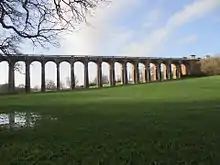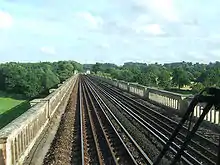Ouse Valley Viaduct
The Ouse Valley Viaduct (or the Balcombe Viaduct) carries the London-Brighton Railway Line over the River Ouse in Sussex. It is located to the north of Haywards Heath and to the south of Balcombe. Known for its ornate design, the structure has been described as "probably the most elegant viaduct in Britain."[1][2][3]
Ouse Valley Viaduct | |
|---|---|
 Northern end of Ouse Valley Viaduct | |
| Coordinates | 51°02′05″N 0°06′52″W |
| Carries | London and Brighton Railway |
| Crosses | River Ouse, Sussex |
| Locale | Between Haywards Heath and Balcombe |
| Other name(s) | Balcombe Viaduct |
| Maintained by | Network Rail |
| Heritage status | Grade II* listed building |
| Characteristics | |
| Pier construction | Brick |
| Total length | 450 m (1,480 ft) |
| Width | 13 m (43 ft) |
| No. of spans | 37 |
| Rail characteristics | |
| No. of tracks | 2 |
| Track gauge | 1,435 mm (4 ft 8 1⁄2 in) |
| History | |
| Designer | John Urpeth Rastrick |
| Contracted lead designer | David Mocatta |
| Construction end | 1842 |
| Construction cost | £38,500 (1841) |
| Opened | July 1841 |
| Statistics | |
| Daily traffic | Brighton Main Line |
| Location | |

| |
Construction of the Ouse Valley Viaduct commenced by the London & Brighton Railway company during 1839.[4] It was designed by the principal engineer for the line, John Urpeth Rastrick, in association with the architect of the London to Brighton railway, David Mocatta. The viaduct is 96 feet (29 m) high and is carried on 37 semi-circular arches, each of 30 feet (9.1 m), surmounted by balustrades, spanning a total length of 1,480 feet (450 m). Each pier contains a jack arch with a semi-circular soffit, which had the benefit of reducing the number of bricks required.[5] The roughly 11 million bricks required for its construction were mostly shipped up the River Ouse (via Newhaven and Lewes) from the Netherlands. On 12 July 1841, the viaduct was officially opened to train services, although the structure was not fully completed until the following year.
Despite the structure's fine design, materials and architectural features, the viaduct has had an expensive and problematic history. The first major restoration work occurred during the 1890s, during which sections of the original brickwork were entirely replaced in the belief that this would increase the structure's strength. However, the viaduct suffered considerable decay during the majority of the twentieth century. By May 1983, the viaduct had been recognised as a Grade II* listed structure. Between March 1996 and September 1999, the viaduct was subject to an extensive restoration by national rail infrastructure owner Railtrack; this work was part-funded by the Railway Heritage Trust, English Heritage and West Sussex County Council.
Construction
During July 1837, an Act of Parliament was passed which gave the London & Brighton Railway company assent to construct its proposed railway line between London and the south coast.[4] The route selected, which was surveyed by a team headed by Sir John Rennie, was fairly direct but had the downside of crossing over some relatively hilly terrain. As a consequence of a decision to limit gradients along the line to 1 in 264, the construction of a total of four tunnels and a single viaduct, the latter crossing the Ouse Valley between Balcombe and Haywards Heath in West Sussex, was necessary.[4]

Construction of the new line commenced during July 1838; work to build the ornate viaduct began during the following year.[4] It was designed by the principal engineer for the line, John Urpeth Rastrick, in association with the architect of the London to Brighton railway, David Mocatta.[6][7] The contractor appointed for its construction was Benjamin Baylis.[4] The total cost of the viaduct's construction reportedly came to £38,500[8] (equivalent to about £3.6 million in 2016[9]).
The viaduct was designed as a relatively elegant structure, being around 1,600 feet (500 m) in length and carrying a straight line over 37 identical arches. Each of these semi-circular arches had a span of 30 feet (9.1 m) and was supported upon tapered red brick piers.[4] Each pier was almost divided into two separate halves by 9.8-foot (3 m) vertical voids, capped by semi-circular rings at the top and base, as a weight-saving measure. This approach is credited with giving the structure a relatively slender appearance.[4][6] The foundations of each pier is provided with two courses of inclined footings, which have a total depth of just over 3 feet 3 inches (1 m).[6]
In terms of its composition, the viaduct is largely composed of traditional red bricks and smooth limestone.[6] The contrast between the two materials effectively highlights the deck and upper elements of the structure to the observer, although the limestone has been subjected to considerable weathering and staining since its original installation. Elements of both the brickwork and the limestone have been replaced over time in order to maintain the structure's integrity, extend its operational life, and to restore its appearance to better resemble its earlier state.[6] At its highest point, the Ouse Valley Viaduct is 96 feet (29.3 m) above the river crossing beneath it.[4]
In the process of constructing the viaduct, it has been estimated that around 11 million bricks, many of which had been shipped across the English Channel from the Netherlands to Newhaven and Lewes in addition to some locally produced bricks, had been used for the structure.[5][10] Furthermore, Caen stone was also brought from Normandy in France; this material was used for the classically balustraded parapets, string courses, pier caps and the four small rectangular Italianate pavilions.[4][6] Building materials were transported to the construction site on barges up the Ouse River Navigation. At each end of the abutment is an ornamental square open tower, the brickwork of which is faced with stone from Heddon Quarries near Newcastle-upon-Tyne.[5]
Opening

The Brighton main line was opened in two sections because completion was delayed by the need to construct some major earthworks.[4] The viaduct was officially opened when the section between Norwood Junction and Haywards Heath was opened on 12 July 1841. Initially, there was only one track across the structure in operation; the second line, along with the viaduct's ornate stone parapets and pavilions, was not completed until the following year.[4][6]
By 1846, the viaduct had become part of the London, Brighton and South Coast Railway.[4] In 1923, as a result of the Railways Act 1921, it became part of the Southern Railway network. It remained under Southern's ownership until January 1948, when the nationalisation of the Big Four railway companies formed the publicly owned railway operator British Railways.[4]
Maintenance and restoration
The first major restoration work occurred during the 1890s. This had focused upon repairs to the brickwork because engineers of the late Victorian era were concerned that the original lime mortar used in the viaduct's construction was inadequate. It was decided that this should be replaced with cement mortar. However, replacement facing brickwork and substandard mortar eventually caused its own failures prompting more expensive repairs later on.[4] This was likely due to the repair work having borne a greater share of the structure's load than intended, resulting in an accelerated failure rate; poorly bonded header bricks is another probable culprit for its ineffectiveness. Additionally, the parapets and pavilions, although made from Caen stone (a high-quality limestone), have been subjected to heavy weathering.[4]

By 1956, the damage to the viaduct was extensive but the cost of refurbishment work was deemed to be too high by British Rail.[4] The degradation was partially a consequence of the structure's long lifespan: when originally constructed, its designers had intended for the structure to have a design life of 120 years, which it had long since exceeded.[6] By May 1983, the viaduct had been officially recognised as a Grade II* listed structure.[11][12]
By the 1980s, the eight pavilions present on the viaduct were in such a poor condition that some of their roofs had fallen in and the installation of internal props was required to stop them collapsing further.[4] As a consequence of its heritage status, all envisioned alterations to the viaduct need to be reviewed and agreed by English Heritage.[6] When British Rail proposed to dismantle the original pavilions and rebuild them using reconstituted stonework, English Heritage refused permission to do so; accordingly, there were no substantial restoration performed to the viaduct during this period, a decision which British Rail publicly attributed to the sizeable cost of undertaking such work. The fabric of the structure continued to deteriorate over the next decade; sections of the stonework began to fall away from the balustrades and parapets during this time.[4][10]
Starting in March 1996, the viaduct underwent a £6.5 million renovation overseen by national rail infrastructure company Railtrack and partially funded by grants from West Sussex County Council, Railway Heritage Trust[13] and English Heritage.[10][6] Harder-wearing limestone was imported from Bordeaux to ensure the closest match with the existing Caen stone in the balustrades and pavilions.[14][15] Some of the piers had to be reconstructed because of failures in the Victorian brickwork. The new bricks were handmade in a variety of sizes to suit the existing brickwork and set in a sand, cement and lime mortar; stainless steel anchoring was used to firmly fix the new stone to the old stonework.[4] Throughout the work, one of the lines always remained open while restoration activity was being carried out on the other side of the viaduct. The project, which took more than three years, was completed during September 1999.[10]
References
Citations
- Our Transport Heritage. transportheritage.com, Retrieved: 4 June 2018.
- "Under the Arches." The Argus, 22 November 2014.
- "Stunning drone photos show off Britain's most beautiful landmarks". The Telegraph. 20 October 2016.
- "Ouse Viaduct, Balcombe." engineering-timelines.com, Retrieved: 4 June 2018.
- Turner (1977), p. 124.
- Jefferson, Lloyd. "A critical analysis of the Ouse Valley Viaduct, West Sussex." Archived 23 April 2016 at the Wayback Machine University of Bath, April 2010.
- Burman & Stratton (2014), p. 61.
- Body, Geoffrey (1989). Railway of the Southern Region. Patrick Stephens. p. 141. ISBN 1-85260-297-X.
- "Inflation calculator." Bank of England, Retrieved: 4 June 2018.
- Husband, Mark. "Restoration of the Ouse Valley Viaduct." Institute of Civil Engineers, 2010.
- Historic England. "OUSE VALLEY RAILWAY VIADUCT THE OUSE VALLEY RAILWAY VIADUCT (1366101)". National Heritage List for England. Retrieved 16 January 2016.
- "Ouse Valley Viaduct." transporttrust.com, Retrieved: 4 June 2018.
- Railway Heritage Trust
- "Trusting in Trusts: The Railway Heritage Trust: conservation and change". www.ihbc.org.uk. Archived from the original on 3 September 2003. Retrieved 4 June 2018.
- "Ouse Valley Viaduct (aka Balcombe Viaduct)." bestofengland.com, Retrieved: 4 June 2018.
Bibliography
| Wikimedia Commons has media related to Ouse Valley Viaduct. |